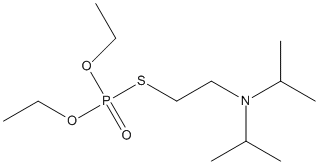Diisopropyl-amiton
General
Type : Organophosphate,Nerve Agent V-series,Sulfur Compound,Insecticide
Chemical_Nomenclature : N-(2-diethoxyphosphorylsulfanylethyl)-N-propan-2-ylpropan-2-amine
Canonical SMILES : CCOP(=O)(OCC)SCCN(C(C)C)C(C)C
InChI : InChI=1S\/C12H28NO3PS\/c1-7-15-17(14,16-8-2)18-10-9-13(11(3)4)12(5)6\/h11-12H,7-10H2,1-6H3
InChIKey : SMUBECNGNBBISQ-UHFFFAOYSA-N
Other name(s) : Diisopropyl amiton,S-(2-(Diisopropylamino)ethyl) O,O-diethyl phosphorothioate,KS-000023UV,AKOS024464867,CL-0778,DIPR-Amiton
MW : 297.39
Formula : C12H28NO3PS
CAS_number : 219662-56-3
PubChem : 86346439
UniChem : SMUBECNGNBBISQ-UHFFFAOYSA-N
IUPHAR :
Wikipedia :

Target
References (2)
| Title : Catalytic efficiencies of directly evolved phosphotriesterase variants with structurally different organophosphorus compounds in vitro - Goldsmith_2016_Arch.Toxicol_90_2711 |
| Author(s) : Goldsmith M , Eckstein S , Ashani Y , Greisen P, Jr. , Leader H , Sussman JL , Aggarwal N , Ovchinnikov S , Tawfik DS , Baker D , Thiermann H , Worek F |
| Ref : Archives of Toxicology , 90 :2711 , 2016 |
| Abstract : Goldsmith_2016_Arch.Toxicol_90_2711 |
| ESTHER : Goldsmith_2016_Arch.Toxicol_90_2711 |
| PubMedSearch : Goldsmith_2016_Arch.Toxicol_90_2711 |
| PubMedID: 26612364 |
| Title : Oxidative biodegradation of phosphorothiolates by fungal laccase - Amitai_1998_FEBS.Lett_438_195 |
| Author(s) : Amitai G , Adani R , Sod-Moriah G , Rabinovitz I , Vincze A , Leader H , Chefetz B , Leibovitz-Persky L , Friesem D , Hadar Y |
| Ref : FEBS Letters , 438 :195 , 1998 |
| Abstract : Amitai_1998_FEBS.Lett_438_195 |
| ESTHER : Amitai_1998_FEBS.Lett_438_195 |
| PubMedSearch : Amitai_1998_FEBS.Lett_438_195 |
| PubMedID: 9827544 |